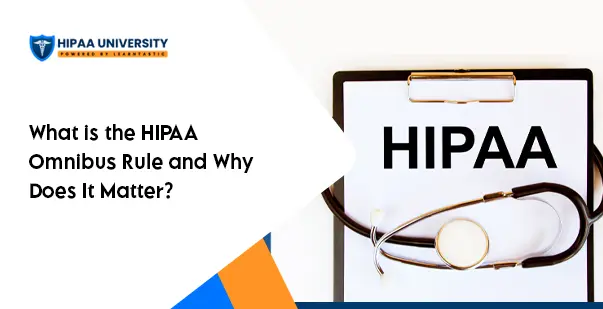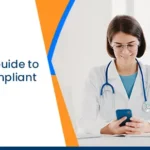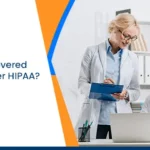What is the HIPAA Omnibus Rule, and Why Does It Matter?

September 3, 2024
Table of Contents:
- Introduction
- Understanding HIPAA Omnibus Rule
- The Role of Omnibus Framework in HealthTech
- The Purpose of HIPAA Omnibus Rule
- Key Enhancements and Expansions in Omnibus Rule
- What Does the Omnibus Rule Mandate?
- Primary Components of Omnibus Rule
- Latest Changes to the HIPAA Omnibus Rule
- HIPAA Omnibus Rule For Privacy and Security
Do you know that healthcare data breaches have consistently ranked as the costliest across all sectors for 13 consecutive years? IBM states that the average cost for beaches has now surged to $10.93 million, which represents a whopping 53.3% rise over the past three years. These statistics underscore the importance of driving healthcare organizations to prioritize data security and adhere to HIPAA training and regulations.
The trend has been growing since the release of one of the most recent sets of rules that every healthcare organization needs to consider—the HIPAA omnibus rule! The Omnibus Rule is part of the HIPAA framework regulations, which collectively safeguard the privacy and security of patient health information.
In this blog, we will discuss the HIPAA omnibus rule, its role in HIPAA compliance, and the new changes you need to be aware of. Let’s get started!
Understanding HIPAA Omnibus Rule
The HIPAA omnibus rule was enacted in January 2013 to enhance the privacy and security of PHI (Protected Health Information). It was designed to harmonize every previously passed regulation into one cohesive set of rules, made up of robust security protocols that are also easy to understand and comply with.
The HIPAA omnibus rule made changes to the Privacy, Security, and Enforcement Rules to align with the HITECH Act, established the Breach Notification Rule, and included new standards for the GINA Act. The rule ensures compliance while establishing the necessary agreements to facilitate secure sharing within the healthcare industry. It extended HIPAA’s coverage in response to the complex web of digital interactions and third-party engagements that feature the modern healthcare sector.
The Role of Omnibus Framework in HealthTech
The exchange and transmission of patient data within healthcare facilities necessitates the delivery of quality patient care across various professionals and organizations. However, such exchange of Patient Health Information (PHI) comes with a significant responsibility – the assurance of confidentiality and security.
The omnibus framework not only recognized the importance of secure data management but also made it mandatory to protect patient information. This legislative foundation has a cumulative set of rules that signifies the growing reliance on technology in healthcare while emphasizing the demand to uphold patient data privacy and security. Non-compliance or violations of HIPAA can result in substantial fines and may also affect your organization’s reparations.
Read More: What is the Purpose of HIPAA in 2024
The Purpose of HIPAA Omnibus Rule
HIPAA Omnibus Rule 2013 incorporates elements from the Health Information Technology for Economic and Clinical Health Act (HITECH) and Section 105 Title I of the Genetic Information Nondiscrimination Act of 2008 (GINA). The key purpose of the Omnibus rule is to expand the individual’s rights to access and control their health information.
Patients are now entitled to an electric copy of their PHI, which will promote greater engagement in the healthcare domain. The rule also allows individuals to restrict the discovery of their PHI to health plants for specific purposes. This means the entities handling patient formations are now directly responsible for meeting the HIPAA privacy and security requirements.
Key Enhancements and Expansions in Omnibus Rule
The ultimate goal of the omnibus rule HIPAA is to ensure that the entire chain of data handling maintains the highest standards of security and confidentiality. Let us explore some key expansions made in the framework.
Privacy Protections
- Extended coverage to HIPAA’s privacy requirements to business associations including contractors and subcontractors, ensuring that PHI is protected throughout the data handling process.
- Marketing and fundraising restrictions to limit the use of PHI without patient authorization, protecting from unwanted solicitations.
- Prohibition on the sale of PHI to ensure that patient information is not being commercially exploited.
Security Enhancements
- Stringent security measures to protect electronic PHI through regular risk assessments, encryption, and access controls.
- Comprehensive security programs to address potential threats and vulnerabilities, ensuring the complete protection of PHI.
Enforcement and Penalties
- Tiered Penalty Structure for HIPAA violations with penalties scaled based on the level of the negligence and the nature of the violation.
- Mandatory Audits to support the Office for Civil Rights, ensuring compliance and addressing issues proactively.
Breach Notification Requirements
- Expand the definition of breach, including the acquisition, access, use, or disclosure of PHI, demonstrating a low probability that the data has been compromised.
- Timely notifications to the affected individuals, the OCR involves unsecured PHI within a specific time frame, ensuring transparency.
What Does the Omnibus Rule Mandate?
The HIPAA omnibus rule aims to align with provisions outlined in the HITECH Act, finalize the breach notification rule, and incorporate the standards designated by the passage of the GINA Act. Here’s a brief breakdown of the provisions mandated by the omnibus framework.
-
Direct Liability for Business Associates
In the previous version, if a business associate violated HIPAA, the covered entity would bear the liability. However, the latest omnibus rule amended it by making business associates or their substrate directly liable for compliance.
- Strengthening Limits on Uses and Disclosures
Notable changes have been incorporated in the rule, granting patients the right to opt out of fundraising communications and requiring authorization to sell PHI.
-
Expansion of Individual Rights
The rule expanded the people’s rights regarding the restriction of disclosures and the request for copies of their own PHI. Covered entities have now become obligated to agree to such requests and to provide electronic copies of their information.
-
Modifications to Notice of Privacy Practices
Covered entities should modify and restore their privacy practices to reflect their expanded rights and robust limitations. It will ensure that every patient is aware of their rights and modifications in privacy practices. Compliance with redistribution prices will minimize unnecessary costs and administrative burdens.
-
Changes in Authorization
The omnibus rule introduced new requirements to obtain authorization before the sale of PHI. Certain events were removed from the list of disclosures, like disclosing a child’s communication status or the information of deceased individuals after 50 years.
-
Adaptation of a Four-Tiered Civil Monetary Penalty Structure
The penalty for HIPAA violations was $100 per violation, with an annual charge of $25,000, which is applicable for willful neglect cases. However, the latest omnibus rule launches a more stringent penalty structure with four-tiered with raised fines. Violations of HIPAA will now occur with a penalty of upto $50,000 per violation with a maximum annual cost of $1,50,00,000.
Read More: What are the Penalties for HIPAA Violation
Primary Components of Omnibus Rule
The HIPAA Omnibus rule imps events for crucial companies that refine and clarify the roles within the healthcare field. These key components aim to provide privacy protections, enhance security measures, and refine compliance requirements. Let us explore the components outlined in the rule.
-
Covered Entities:
Covered entities under HIPAA rule encompass various entities involved in healthcare operations and transitions. They include,
- Healthcare Providers: Any individual or organization that furnishes healthcare services, including hospitals, clinics, physicians, psychologies, and chiropractors.
- Health Plans: Any entity that provides or pays for medical care, including health insurance companies, Medicare, Medicaid, and group health plans.
- Healthcare Clearinghouses: Any entity that processes nonstandard health information into standard formation, including billing services and repricing companies.
-
Business Associations:
Business Associates are individuals or entities that perform activities or functions on behalf of or provide services to covered entities involved in the disclosure of PHI. Some examples of PII include,
- Third-party admissions that assist health plants with claims processing or administration.
- Billing companies that handle billing services for healthcare providers.
- IT service providers that manage electronic health records and provide cloud storage services.
Latest Changes to the HIPAA Omnibus Rule
The HIPAA Omnibus Rule has drastically changed the healthcare landscape, driving professionals to adapt their practices to meet the updated regulatory standards. Here’s an in-depth look at the key modifications that brought about the Omnibus rule.
- Breach Notification
Under the previous rule, healthcare entities were only obligated to report breaches if they affected 500 or more individuals. However, under the new rule, any impression used to disclose an individual’s PHI must be reported. The modification aims to improve transparency and ensure every breach is addressed in a timely manner.
- Business Associated Requirements
The rule also demands updates to the existing business associate agreements to ensure compliance with the new requirements. The covered entities must enact their review process to assess the associate’s compliance and employ liability protection within their contracts.
- Marketing Restrictions
The Omnibus rule imposes stricter restrictions on marketing activities involving patient data and gives individuals greater control over the use of their PHI. For instance, authorization from the respective patient is required if a covered entity gets compensation from a third party to promote its product or service.
- Genetic Information Protection
The GINA Act protects individuals from discrimination based on their genetic information. The omnibus rule employs the GINA’s provisions in their HIPAA regulations to protect the initial data and prevent any misuse.
- Research Consent Requirements
The Omnibus rule simply is the consent requirement for research participation. Under the oldest rule, researchers only need a single consent form to cover multiple areas of study, reducing the administering burden.
HIPAA Omnibus Rule For Privacy and Security
The thriving health-tech sector will bring about amazing innovations, while also potentially creating new cybersecurity risks. This is where the Omnibus Rule, a key amendment of the HIPAA Act, plays a prominent role in a rapidly evolving environment. The HIPAA omnibus rule updates and expands HIPAA’s privacy and security protections by making significant changes to how protected information is handled in the healthcare and technology sectors. Despite the ongoing advancements in the health industry’s cybersecurity efforts and defense fortification, it is still necessary to stay updated on compliance requests.
Succeeding in this regulatory landscape will demand more than just understanding. Creating strong, flexible strategies and effective training on compliance will be necessary. Signing up for HIPAA training can assist in streamlining that procedure and ensuring uninterrupted functioning in the rapidly evolving HealthTech industry.





